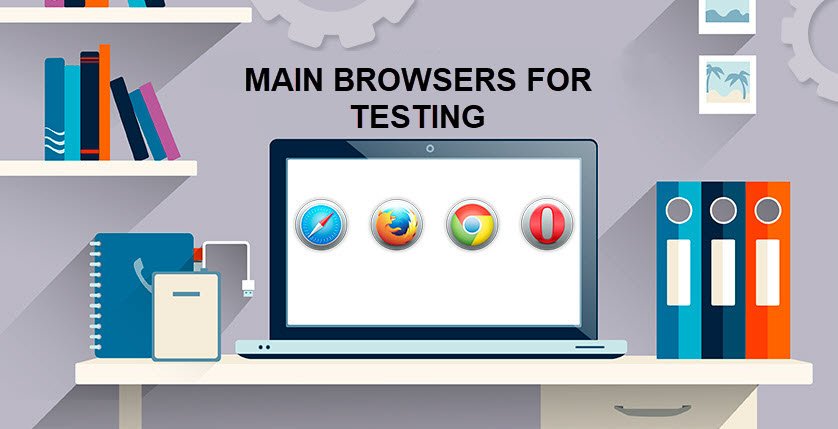Within the immensely fast-developing world of the internet, ensuring compatibility across distinctive browsers and systems is paramount.
However, the conventional approach of preserving a plethora of browsers locally for testing purposes can be cumbersome, time-consuming, and lacking in depth. Browsers available online provide a progressive solution that gives developers and QA groups the flexibility and convenience of gaining access to a multitude of browser environments without the need for local installations.
Developers and testers can explore the practical applications of leveraging web browsers online for expedited testing needs. From price-effective solutions to stronger accessibility and collaboration features, online browser systems are remodeling the use of cross-browser testing.
What is a Web Browser?
The Internet browser is a software program that allows you to explore the World Wide Web. It serves as an interface between the server and the patron, making requests to the server for web content material and services. It functions as a compiler, producing HTML, which is used to construct a webpage. While we look for something on the net, the browser creates an HTML page with textual content, hyperlinks, photos, and other elements like style sheets and JavaScript exercises.
Tim Berners-Lee designed the first web browser, the sector-wide net, in 1990. Later, it becomes Nexus. Mark Andreessen and his colleagues designed a new browser called Mosaic in 1993. It was the first browser to display both text and graphics on the device’s screen. In 1994, he also created another browser, Netscape. The next year, Microsoft released Internet Explorer, a web browser that came pre-installed with Windows. Following this, several browsers with diverse functionality were developed, including Mozilla Firefox, Google Chrome, Safari, and Opera.
Functions performed by a Web Browser
A web browser performs a variety of tasks to improve the user browsing experience. A number of the primary features of a browser are indexed underneath:
- Rendering a web page: while any person visits an internet site, the browser automatically downloads the page created using HTML, CSS, and JavaScript documents from the server. HTML specifies the page’s structure and content using tags and div elements, CSS adds style to the page, and JavaScript gives interactivity and dynamic components.
- Navigation: Browsers offer an easy interface for exploring the internet. Users may type a website’s address known as Uniform Resource Locator(URL) straight into the address bar, and the browser will display the precise page. One can also navigate to other relevant pages by clicking on hyperlinks embedded inside web pages.
- Tabbed Browsing: Tabs transformed online browsing by allowing you to visit several websites in the same browser window. Rather to creating separate browser instances for each webpage, you may create multiple tabs, each representing a distinct webpage. This function enables multitasking and allows you to easily browse between multiple websites without cluttering your screen.
- Bookmarks and records: Browsers allow you to save your preferred websites as bookmarks. Bookmarks serve as shortcuts, allowing you to unexpectedly return to websites without having to memorize their URLs. Browsers also maintain track of the websites you’ve visited, creating a chronological report that you can use to revisit formerly visited web pages.
- Search capability: Most browsers incorporate a search bar, which is commonly placed inside the toolbar. This search bar integrates with prominent search engines like Google, Bing, and DuckDuckGo.
In general, web browsers play a crucial role in contemporary computing, empowering users to explore the internet, engage with online offerings, and access statistics with exceptional convenience and performance.
The Components of a Web Browser
A browser has two components: the front end and the back end. The complicated back end supports the browser’s essential functionality, while the front end interacts with users.
1. Frontend:
The frontend part of a browser is the user-facing portion with which you interact. It consists of a graphical user interface and user experience (UI/UX) features including the address bar, navigation buttons, bookmarks, and tabs. The front end also renders web pages made using technologies like HTML, CSS, and JavaScript, which show material, graphics, and interactive components on your device’s screen. When the user interacts with the front end by inputting a URL, clicking on links, or utilizing browser capabilities, it connects with the backend to retrieve the required web page resources.
2. Backend:
The back end of a browser refers to the various functions and procedures that take place behind the window. It facilitates the connection between the browser and web servers, retrieves and manages web page resources, and processes the code that makes up web pages including databases. The backend reads HTML, CSS, and JavaScript files, ensuring that web pages are properly displayed. It controls network connections, supports numerous protocols such as HTTP and HTTPS, and handles security features like encryption and certificate verification.
A browser’s front-end and back-end components are a part of the client-server architecture that is integrated dynamically to deliver a seamless browsing experience.
How does a Web Browser work?
Web browsers are charged for retrieving and presenting online material to users. When a user inputs a URL or clicks on a link, the browser plays an advanced set of steps to get online content from a server and show it on the consumer’s tool.
The steps are mentioned below:
- The system starts with a domain name system (DNS) decision, wherein the browser converts the domain call into an IP address to discover the server that stores the web page.
- The browser then makes an HTTP request to the server, which includes the path and parameters for the requested useful resource.
- After receiving the request, the server offers an HTTP response to the browser that includes the requested resource in HTML, CSS, and JavaScript code.
- The browser’s rendering engine knows and displays the code, allowing the web page to be shown on the user’s tool.
- CSS stylesheets are used to format web page content, such as fonts, shades, and layouts.
- The browser may also run JavaScript code on the internet page to feature interactivity and dynamic conduct.
As new content is added or modifications are made to the online page, the browser refreshes the display.
Web Browsers for Expedited Testing
Using online browsers for expedited testing can be a game-changer for developers and QA teams. These platforms offer a handy solution for cross-browser testing without the need to install more than one browser locally. Here is a breakdown of how this approach may be useful:
- Cost-effective: Setting up and maintaining a variety of browsers on local machines can be highly expensive and time-consuming. Online browser platforms typically provide subscription-primarily based models, allowing groups to access a huge range of browsers and running systems without the overhead of individual installations.
- Time savings: With online browsers, there may be no need to look ahead to prolonged downloads or updates. Customers can quickly spin up digital instances of the desired browser surroundings and start testing without delay, streamlining the development system.
- Accessibility: Online browser platforms permit access to browsers across unique devices and operating systems. This accessibility ensures comprehensive testing throughout various environments, inclusive of older browser variations and cellular devices.
- Scalability: As task necessities evolve, online browser systems can effortlessly scale to accommodate changing needs. Whether or not testing on a single browser version or across more than one configuration concurrently, these platforms provide flexibility without the need for extra infrastructure investments.
- Safety: Online browser structures often appoint strong security features to shield user facts and ensure compliance with industry standards. This includes capabilities including isolated packing containers, secure connections, and information encryption, imparting peace of mind for sensitive testing situations.
By leveraging online browsers for expedited testing needs, teams can streamline their improvement workflows, improve testing coverage, and deliver higher-quality software program merchandise in less time.
LambdaTest for Expedited Web Browser Testing
It provides developers and QA specialists instant access to real browsers and devices for comprehensive testing. By eliminating the need for local installations and seamlessly integrating with popular automation testing tools, LambdaTest accelerates testing workflows and facilitates faster feedback loops.
Utilizing parallel testing, collaborative features, and test automation frameworks like Selenium, LambdaTest empowers teams to effectively validate the compatibility, responsiveness, and performance of their web applications across various environments.
LambdaTest offers a robust and user-friendly platform for streamlined web browser testing, enabling teams to deliver web applications with confidence and efficiency. Leveraging its cloud-based infrastructure and extensive testing capabilities, teams can optimize their testing processes, reduce time-to-market, and ensure a seamless user experience across all browsers and devices.
Advantages of Using Web Browser for Testing Needs
Web browsers have built-in developer tools that allow testers to debug code, analyze page components, and mimic network circumstances, increasing the accuracy and efficiency of testing operations. Furthermore, easy connection with common testing frameworks enables automated testing, execution of test scripts, and creation of test results right from the browser. Real-time feedback and dynamic validation features enable testers to quickly discover and address errors, resulting in quicker turnaround times and higher software quality.
Furthermore, the enormous community support for web browsers offers useful insights, best practices, and troubleshooting assistance, allowing testers to efficiently improve their testing workflows. Overall, using web browsers for testing allows teams to speed up the testing process, boost testing coverage, and provide high-quality online applications that fulfill user expectations and performance standards.
Disadvantages of Using Web Browser for Testing Needs
While internet browsers offer convenience and familiarity for testing desires, they also come with several negative aspects that may impact testing effectiveness. These encompass barriers to accessing older or less commonly used browser variations, differences in rendering engines leading to inconsistencies throughout browsers, dependency on internet connectivity, which might also avert testing in offline environments, and limited control over testing environments for simulating unique eventualities.
Additionally, protection concerns arise from testing in a browser environment, and overall performance overhead may be a factor when running resource-extensive test scripts. Moreover, browser-specific bugs can also require extra effort and time to pick out and address. Those challenges underscore the significance of supplementing browser-primarily-based testing with extra tools and processes to ensure complete testing insurance and mitigate capability risks.
Conclusion
In the end, the use of online browsers for expedited testing gives a compelling solution to the challenges faced by developers in ensuring cross-browser compatibility and great assurance. While web browsers provide familiarity, accessibility, and powerful developer tools, they also come with obstacles, including access to restricted browser variations, variations in rendering engines, and dependence on internet connectivity. However online browser structures like LambdaTest provide a scalable, cost-effective, and efficient alternative by offering access to a variety of actual browsers and devices, enabling parallel testing, helping collaboration, and seamlessly integrating with testing frameworks.
As the digital world continues to grow, online browser systems are poised to play a more and more pivotal role in shaping the future of web browser testing, empowering testers to satisfy the ever-growing demands of the virtual landscape efficiently.




